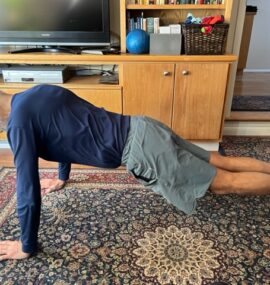Muscle strength declines in later life
You might not consider “seniors” and “muscle” in the same thought. Aging is a complex process that typically involves, among other things, progressive loss of muscle mass and strength. Muscle deterioration predicts unfavorable outcomes, such as increased risks of mortality, falls, sarcopenia, and dementia.
Mortality
Reduced muscle mass and/or strength seems to contribute to disability in old age. The Health, Aging, and Body Composition (Health ABC) study investigated the relation of body composition changes to adverse health outcomes in older adults. Researchers used data from 2,292 participants (average age 74 years) over an average follow-up period of 5 years to determine if strength and muscle mass of older people were related to risk of death. Both grip strength and quadriceps strength were strongly correlated to risk of mortality. At follow-up, the odds of survival for men with the lowest and highest quartiles of leg strength were 91 and 70 percent, respectively. For women, the comparable odds were 98 and 88 percent. Researchers found no upper threshold in the association with either grip or quadriceps strength and risk of death. Thus, within the ranges observed in this study, more strength was better than less. The results indicates a positive effect of strength training for older people.
Falls
Loss of muscle mass and strength leave community-dwelling older adults at increased risk of falling. Would lower muscle mass and strength predict increased risk of falls both prior to and after hospitalization? Data from 378 patients with an average age of 80 years in the VU University Medical Center in the Netherlands provide an answer. Patients were assessed within 48 hours after admission and three months after discharge. Muscle mass was measured using multi-frequency bioelectrical impedance analysis. Muscle strength was measured using a hand-hand dynamometer. Patients self-reported the number of falls they experienced during the 6 months prior to admission and the 3 months after discharge. Prior to hospitalization, 41 percent of men and 50 percent women patients reported at least one fall. After discharge, 23 percent of men and 18 percent women patients reported at least one fall. After accounting for confounding factors, lower handgrip strength predicted significant 6 and 7 percent greater odds of at least one pre-admission and post-discharge fall, respectively, for men but not women. For men, lower skeletal muscle mass predicted significant 7 percent higher risk of at least one post-discharge fall.
Sarcopenia
Loss of muscle strength in older people can diminish functional capabilities, leading to sarcopenia. This condition reflects loss of muscle mass and function that reduces mobility, diminishes quality of life, and increases fall-related injuries, which require costly hospitalization and extended rehabilitation. Nursing home residents have higher risk of sarcopenia than community dwelling older adults. Conflicting research regarding whether sarcopenia predicts increased risk of death for nursing home residents prompted Chinese researchers to conduct a systematic review and meta-analysis of relevant prospective cohort studies. Data pooled from 6 studies showed a significant 86 percent higher risk of death for nursing home residents with sarcopenia compared to residents without sarcopenia. What might account for this result? Nursing home residents often have multiple chronic conditions including malnutrition, disability, and cognitive dysfunction, all of which could increase risk of death. Thus, helping nursing home residents build muscle strength might help them live longer and better.
A recent lengthy review concluded that age-related loss of muscle mass is linked to reduced muscle fiber number and size. This trend largely arises from the progressive loss of motoneurons. Muscle function progressively declines because restoration of function of muscle fibers by the remaining motoneurons does not adequately compensate for loss of motoneurons. Increasing physical activity and improving diet, especially boosting protein intake, could help alleviate sarcopenia in older people, improving their quality of life and reducing medical care costs.
Alzheimer’s disease
Alzheimer’s disease (AD) patients typically have low levels of lean body mass. Perhaps the observed protective effect of high levels of physical activity on risk of AD might arise partly through physical activity helping to maintain lean body mass. Researchers used the used the statistical technique of mendelian randomization to assess the links between lean body mass and prevalence of AD in 450,243 participants in the UK Biobank. Results showed a significant 12 percent decline in the odds of AD with each 1 standard deviation increase in appendicular (arms, legs) lean mass. In addition, each 1 standard deviation increase showed a significant increase in cognitive performance. Increasing levels of physical activity might help older Americans keep their brains in better working order.
Slow the rate of muscle decline
Physical activity helps maintain muscle mass in older age. Scientists used cross-sectional data from 2,000 persons aged 3-96 in the International Atomic Energy Doubly Labeled Water database to test this idea. Physical activity was calculated as the ratio of daily total energy expenditure to resting energy expenditure. High levels of physical activity during the growth years (between 18 and 30) significantly increased the odds of higher fat-free body mass, which includes muscle, bones, and connective tissues. For physically active participants age 18 years or older, the mean fat-free mass index (adjusted for height) was 1.3 and 1.4 units greater for men and women, respectively, compared to sedentary participants. For physically active participants 80 years and older, the mean fat-free mass index (adjusted for height) was 0.7 and 1.0 units greater for men and women, respectively, compared to sedentary participants. Thus, physically activity appeared to slow but not reverse the decline in fat-free mass for octogenarians.
What to do
Maintain a physically active lifestyle. Specifically, engage in some form of strength-building training twice a week. In addition, you might want to increase your intake of protein to help compensate for lower ability to turn protein you eat into muscle protein as you age.








